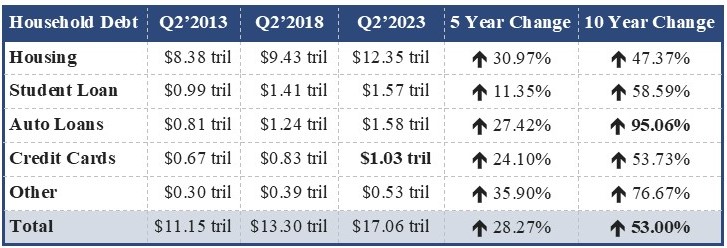Household Debt in the United States has increased 53% in the past 10 years and consumers are becoming less optimistic about their financial futures.
There are 53 banks that saw their consumer loan portfolios grow at least 2.5% during the 12 months ending June 30, 2023 while concurrently witnessing 25% or more growth in delinquent consumer loans. They can be found on page 5 of this week's Jumbo Rate News.
Bauer's LLAMAS Report Bundle provides a 5 quarters of data side-by-side to easily track a bank or credit union's loan growth and delinquencies along with graphs and ratios comparing it to its peers.
U.S. Credit Card Debt Surpasses $1 Trillion
A $30 billion dip in housing debt was offset by a $50 billion rise in non-housing (including credit card) debt in the second quarter 2023. Rising 4.6%, or $45 billion during Q2, U.S. credit card debt at June 30th totaled a record $1.03 trillion according to the Federal Reserve Bank of New York (FRBNY).
Other consumer loans, including retail credit cards, increased $15 billion (to $0.53 trillion), and auto loan balances grew $20 billion (to $1.58 trillion). Student loan balances, however, dropped by $35 billion to end the quarter at $1.57 trillion. Even with that drop, the result was not pretty. Automobile loan balances have nearly doubled in the past 10 years and other household loans are not far behind.
In fact, if you’re not bringing home substantially more in your paycheck than your were in 2013, you are likely feeling the pinch. That is probably why the FRBNY also found that consumer expectations about their financial situations in the future are becoming less optimistic.
That may have also played into the Federal Reserve’s decision to maintain the current Fed Funds rate at between 5.25% and 5.50%. The general consensus is we will see another quarter point increase in November and it looks like rates will stay higher longer than expected.
The FRBNY’s August survey indicates consumers believe inflation will rise, which is contrary to what the Fed’s Open Market Committee (FOMC) is trying to achieve. Jay Powell and the FOMC are trying to get inflation to 2.0% (or at least 2.5%) but so far anyway, it remains stubbornly high.
Perhaps the most disturbing findings from the FRBNY Survey pertained to expected income growth, which is at its lowest since July 2021. In conjunction with expected higher costs for gas, food, medical care, education and rent, that does not bode well for the American consumer. Consumers also see the risk of losing their job as higher than its been since April 2021 while access to credit is expected to become more difficult.
It seems fair to say that Americans are less optimistic about their financial futures. What we want to know is if that feeling will translate into trouble for our nation’s banks.
The 53 banks listed on page 5 all have the following things in common:
- Consumer loans reported at June 30, 2023 are greater than $1 million
- Consumer loans grew by a minimum of 2.5% over the previous 12 months
- Delinquent consumer loans grew by at least 25% during that same period
- Each is rated less than 4-Stars by Bauer
In short, these are some of the banks that could be adversely affected if consumer expectations are met. Let’s just take a look at a couple of them.
3½-Star Compass Savings Bank, Wilmerding, PA is a very small ($61 million asset) community bank. Compass SB’s loan portfolio is 95% residential real estate with consumer loans representing less than 2.7% of the total. A year ago (June 30, 2022) Compass SB had no loans that were 90 days or more delinquent, although it did have $674,000 that was 30 days past due. Of that, $8,000 was auto, the rest was residential real estate (first and second liens).
This year is a whole different ballgame. This June, total loans at Compass SB grew by 22%, its troubled loans grew even more. It now has $66,000 in auto loans and $18,000 in junior home loans that are no longer accruing as well as $917,000 in home loans (mostly first mortgages) that are 30-89 days in arrears. The delinquency rate on its consumer (non-mortgage) loans is 4.56%.
3½-Star Merrick Bank, South Jordan, UT, on the other hand, is a credit card bank with $5.5 billion in assets. As a credit card bank, Merrick Bank’s loan portfolio is entirely comprised of consumer loans. Those loans, which are mostly, but not entirely, credit cards, grew by 7.3% during the 12 months ending June 30, 2023. During that same time-frame, its delinquent loans grew 35%.
Merrick Bank has a lot in its favor though. It is well capitalized, profitable, and has plenty of reserves to cover potential losses.
The same cannot be said for 2-Star Beauregard FSB, DeRidder, LA. Beauregard FSB witnessed just 3.3% growth in consumer loans during the year, but with a 37% increase in delinquent loans, and reserves to cover less than 45% of them, it would be a much rougher ride. At least its loans are diversified.


